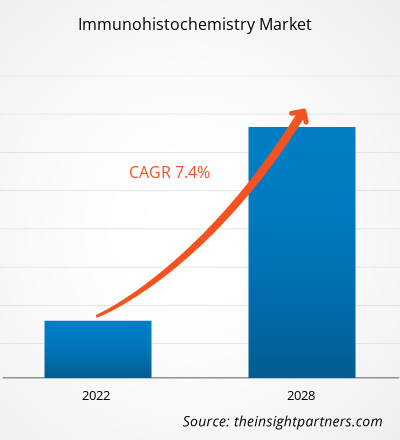[研究报告]免疫组织化学市场规模预计将从 2021 年的 21.7161 亿美元增至 2028 年的 35.8531 亿美元;预计 2021 年至 2028 年的复合年增长率为 7.4%。市场洞察和分析师观点:
免疫组织化学 (IHC) 是一种基于显微镜的技术,用于观察组织样本中的细胞成分,例如蛋白质或其他大分子。它是医疗保健和病理学中常用的工具。IHC 广泛应用于研究应用,通过分析目标分子来研究它们在细胞、分子或组织水平上在健康和患病细胞和组织中的作用。有许多 IHC 方法可用于定位抗原。IHC 主要考虑标本类型和检测灵敏度等参数。全球免疫组织化学 (IHC) 市场规模预计将从 2021 年的 21.7161 亿美元增至 2028 年的 35.8531 亿美元。预计 2021 年至 2028 年期间,该市场的复合年增长率将达到 7.4%。
增长动力与挑战:慢性病和传染病发病率上升
免疫组织化学 (IHC) 是一种重要的应用,利用单克隆和多克隆抗体进行组织鉴定和特定疾病抗原的分布。它主要用于检测多种传染病,例如登革热、肝炎、人类免疫缺陷病毒 (HIV)。肥胖、癌症、糖尿病、心脏病和中风等慢性疾病也被认为是免疫组织化学的主要应用,有助于诊断这些疾病。
根据联合国艾滋病毒/艾滋病联合规划署 (UNAIDS) 的数据,2020 年全球约有 3760 万人感染艾滋病毒。其中,3590 万为成年人,170 万为儿童(<15 岁)。估计 2020 年全球有 150 万人感染艾滋病毒。根据艾滋病毒和艾滋病组织 (AVERT) 的数据,2018 年,美国有 110 万居民感染了艾滋病毒,而亚太地区登记的艾滋病毒感染人口为 520 万。根据欧洲疾病预防控制中心的数据,2018 年欧洲约有 200 万人感染了艾滋病毒。
糖尿病在世界各地老年人口中的发病率很高。超重和肥胖人群的糖尿病患病率更高。根据美国疾病控制与预防中心 (CDC) 2017 年公布的数据,美国约有 3030 万人(占美国总人口的 94%)患有糖尿病。其中,约 2310 万人被诊断患有糖尿病,另有约 720 万人未接受过适当的诊断程序。
全球发达经济体和发展中经济体的肥胖率都在迅速上升。不健康的生活方式和久坐不动等因素是导致肥胖人数增加的主要原因。根据美国国家卫生统计中心 (NCHS) 公布的数据,2015 年至 2016 年间,美国成年人的肥胖患病率预计约为 39.8%,约有 9330 万成年人受到影响。中年人的肥胖发病率(42.7%)明显高于年轻人(35.7%)。美国肥胖人口的增加也导致了医疗支出的上升。
心血管疾病(CVD)包括脑血管病、风湿性心脏病、冠心病等,是全球发病率和死亡率的第一大原因。根据2017年欧洲心血管疾病统计数据,心血管疾病每年导致390万人死亡,在欧盟导致超过180万人死亡,在欧洲占所有死亡人数的45.0%,在欧盟占37.0%。此外,根据美国心脏协会(AHA)2019年的统计数据,美国有1.215亿成年人患有心血管疾病,约占美国成年人口的一半。
此外,全球癌症发病率和死亡率呈上升趋势,癌症已成为人类死亡的首要原因。根据世界卫生组织 2018 年的数据,全球约有 960 万人死于癌症。
此外,美国国家癌症研究所预测,2018 年美国将诊断出约 1,735,350 例新发癌症病例。同样,在中国,根据世界卫生组织的数据,2018 年新发现的癌症病例约为 430 万例,癌症死亡人数为 290 万例。慢性病和传染病发病率的增加预计将在世界范围内产生对免疫测定测试的需求。
自定义此报告以满足您的要求
您将免费获得任何报告的定制,包括本报告的部分内容,或国家级分析、Excel 数据包,以及为初创企业和大学提供超值优惠和折扣
免疫组织化学市场: 战略洞察

- 获取本报告的主要市场趋势。这个免费样本将包括数据分析,从市场趋势到估计和预测。
市场限制 免疫组织化学的相关局限性
您将免费获得任何报告的定制,包括本报告的部分内容,或国家级分析、Excel 数据包,以及为初创企业和大学提供超值优惠和折扣
免疫组织化学市场: 战略洞察

- 获取本报告的主要市场趋势。这个免费样本将包括数据分析,从市场趋势到估计和预测。
免疫组织化学利用抗体的特异性来检测组织或细胞中的靶分子。此外,免疫组化(IHC)已被证明是毒理学研究的一项强大技术。然而,该技术在特异性和准确性方面的一些局限性在一定程度上限制了其应用。
试剂缺乏特异性是一个比人们普遍认识到的更为普遍的问题。缺乏特异性可能导致资源和时间的巨大浪费。此外,该技术的应用也受到抗体物理局限性的限制。此外,如果染色研究设计不周全且控制不当,免疫组织化学可能会产生误导。
尽管该系统是检测特定标记物表达最简单、最便捷的方法,但由于灵敏度不足、每种一抗需要单独与荧光团或酶结合以及染色问题等限制,它在临床和研究应用中效果不佳。因此,IHC 技术的相关限制会在一定程度上阻碍市场增长。
报告细分和范围:
“全球免疫组织化学市场”根据应用、产品、最终用户和地域进行细分。全球免疫组织化学市场根据产品细分为抗体、设备、试剂和试剂盒。全球免疫组织化学市场根据应用细分为诊断和药物检测。 2021年,诊断细分市场可能占据最大的市场份额。全球免疫组织化学市场根据最终用户细分为医院和诊断实验室、研究机构和其他。免疫组织化学市场根据地域细分为北美(美国、加拿大和墨西哥)、欧洲(德国、法国、意大利、英国、俄罗斯和欧洲其他地区)、亚太地区(澳大利亚、中国、日本、印度、韩国和亚太其他地区)、中东和非洲(南非、沙特阿拉伯、阿联酋和中东及非洲其他地区)以及南美洲和中美洲(巴西、阿根廷和南美洲和中美洲其他地区)。
细分分析:
根据产品细分为抗体、设备、试剂和试剂盒。抗体领域很可能在2021年占据最大的市场份额。此外,由于试剂领域目前的使用量、高消费量和产品创新,预计在预测期内,该领域将实现最高的复合年增长率。试剂使研究人员能够以卓越的水平对组织和检测进行深入分析。免疫组织化学中常用的试剂包括组织染色剂、封闭和固定试剂、显色底物、稳定剂、溶剂和蛋白水解酶等。赛默飞世尔科技公司 (Thermo Fisher Scientific Inc.)、Abcam plc.、Enzo Life Sciences, Inc.、QIAGEN 和 Bio-Rad Laboratories 是该领域的主要参与者。新型试剂还能提高数据量和质量的精确度和准确性,并提供出色的服务效果。试剂的现有使用、不断增长的研发支出、不断增加的政府支持和技术创新是预计将在预测期内加强试剂细分市场增长的因素之一。
全球免疫组织化学市场根据应用细分为诊断和药物测试。2021 年,诊断细分市场可能占据最大的市场份额。此外,由于全球各种医疗状况的检测和诊断增加,预计该细分市场的需求在 2021 年至 2028 年期间也将以最快的复合年增长率增长。通过免疫组织化学方法诊断癌症、自身免疫性疾病、传染病和肾脏疾病等各种慢性疾病已变得非常有效。使用抗体、试剂、染料和其他分子诊断工具,可以快速、在更短的时间内获取重要信息。免疫组织化学技术可以准确地解释诊断结果,并为临床医生提供最佳的治疗方法。免疫组织化学技术的其他优势包括识别疾病的遗传和分子病因,从而有助于提供最佳的治疗方法和患者护理。它还有助于治疗应用,能够根据免疫学结果评估治疗技术。此外,免疫组织化学技术比其他医学诊断技术更具成本效益。与医学诊断相比,免疫组织化学诊断仅需几百美元。此外,技术进步使得抗体和分子诊断工具易于获得。因此,由于免疫组织化学在疾病诊断方面的优势,预计市场在预测期内可能会呈指数级增长。全球免疫组织化学市场根据最终用户细分为医院和诊断实验室、研究机构和其他机构。 2021年,医院和诊断实验室细分市场可能占据最终用户市场的最大份额。此外,由于传染病、癌症和自身免疫性疾病的患病率上升,预计未来几年该细分市场也将以最快的速度增长。这些疾病病例的增加预计将推动对其诊断的需求,从而促进该细分市场的增长。医院是任何国家医疗保健体系的重要组成部分。技术进步有助于医院诊断和治疗各种疾病,例如心脏病、神经病、艾滋病毒、肝炎、肿瘤等。医院为患有各种疾病的患者提供广泛的医疗保健和医疗服务。如今,医院为患者提供更好的服务。通常,这类医院提供多种适应症的诊断和治疗服务。大量的患者入院接受手术,而一些患者则直接接受诊断治疗。在入院的患者中,大多数已经患有某些疾病。因此,为了实时监测和控制患者的健康状况,大多数医院都设有临床诊断实验室。因此,医院在免疫组织化学市场中占据了相当大的市场份额,预计在预测期内这一趋势将持续下去。
诊断中心提供组织、细胞和体液的完整分析,提供全面的诊断,以确保为患者提供最高质量的服务和护理。诊断中心拥有现代化的诊断和病理设备和仪器,例如生化分析仪、血液学分析仪、诊断试剂盒、PCR、凝胶电泳等。病理和诊断中心允许患者在几小时到几天内从现场病理学家那里收到详细的报告。例如,成立于1978年的美国实验室控股公司(Laboratory Corporation of America Holdings)是领先的诊断实验室之一,提供全方位的病理和诊断服务。LabCorp以其高质量和富有同情心的患者护理赢得了卓越的声誉。病理技术的进步能够在较短的周转时间内提供快速准确的结果,这可能会推动病理学和诊断中心细分市场在未来几年的增长。
免疫组织化学市场分析,区域分析:
根据地域,免疫组织化学市场分为五个主要区域:北美、欧洲、亚太地区、南美和中美以及中东和非洲。北美是免疫组织化学最大的市场,美国、加拿大和墨西哥是该地区市场的主要贡献者。北美市场的增长特点是癌症患病率的不断上升以及癌症诊断工具的相应增长、免疫组织化学技术的进步以及老年人口的不断增加。此外,不断增长的医疗保健支出可能是北美免疫组织化学市场的主要增长刺激因素。
行业发展和未来机遇:
全球免疫组织化学市场主要参与者采取的各种举措如下:
- 2021 年 7 月,安捷伦科技公司的 PD-L1 IHC 22C3 pharmDx 扩展了非小细胞肺癌 (NSCLC) 的 CE-IVD 标志。它被标记为可在欧盟扩展用于 NSCLC 患者。现在它可以用于识别肿瘤 PD-L1 表达为肿瘤比例评分 (TPS) 50% 的 NSCLC 患者是否可以使用 Libtayo (cemiplimab) 治疗。
- 2020 年 4 月,Bio-Rad 推出了一种基于血液的免疫分析试剂盒,用于检测 Covid-19。这是一种基于血液的免疫检测试剂盒,用于识别导致新冠肺炎 (Covid-19) 的病毒 SARS-CoV-2 的抗体。
- 2020 年 9 月,赛默飞世尔科技公司 (Thermo Fisher) 和 Humanigen 公司达成协议,扩大 COVID-19 单克隆抗体的生产规模。预计这项交易将有助于扩大这家加州生物科技公司 lenlizumab 的生产规模。lenlizumab 是细胞因子风暴 (cytokine storm) 的临床阶段候选药物,该公司正在重症新冠肺炎 (COVID-19) 患者中进行测试,以期在今年之后获得紧急使用批准。
免疫组织化学免疫组织化学市场区域洞察
The Insight Partners 的分析师已详尽阐述了预测期内影响免疫组织化学市场的区域趋势和因素。本节还讨论了北美、欧洲、亚太地区、中东和非洲以及南美和中美洲的免疫组织化学市场细分和地域分布。
免疫组织化学市场报告范围
| 报告属性 | 细节 |
|---|---|
| 市场规模 2021 | US$ 2.17 Billion |
| 市场规模 2028 | US$ 3.59 Billion |
| 全球复合年增长率 (2021 - 2028) | 7.4% |
| 历史数据 | 2019-2020 |
| 预测期 | 2022-2028 |
| 涵盖的领域 |
By 应用
|
| 覆盖地区和国家 | 北美
|
| 市场领导者和主要公司简介 |
|
免疫组织化学市场参与者密度:了解其对业务动态的影响
免疫组织化学市场正在快速增长,这得益于终端用户需求的不断增长,而这些需求的驱动因素包括消费者偏好的演变、技术进步以及对产品优势的认知度的提升。随着需求的增长,企业正在扩展产品线,不断创新以满足消费者需求,并抓住新兴趋势,从而进一步推动市场增长。

- 获取 免疫组织化学市场 主要参与者概述
北美新冠疫情的爆发对美国产生了重大影响。美国是新冠病毒检测阳性患者人数最多的国家。全国各地的医疗研究中心都专注于新冠治疗。由于封锁、旅行禁令和企业倒闭,新冠疫情影响了各国的经济和各行各业。新冠危机使许多国家的公共卫生系统不堪重负,凸显了对卫生系统可持续投资的迫切需求。随着新冠疫情的蔓延,预计医疗保健行业的增长将出现放缓。由于体外诊断产品需求增长以及全球研发活动的增加,生命科学领域蓬勃发展。然而,由于手术数量减少以及设备采购延迟或延长,医疗技术和影像领域的销售额正在下降。此外,预计医疗保健专业人员的虚拟咨询将成为疫情后主流的医疗服务模式。随着远程医疗彻底改变医疗服务方式,数字医疗将在未来几年持续蓬勃发展。此外,临床试验的中断以及随之而来的药物上市延迟,预计也将为未来完全虚拟试验铺平道路。mRNA 等新技术预计将出现并改变制药行业,预计未来几年市场也将出现更多的垂直整合和合资企业。
竞争格局和主要公司:
全球免疫组织化学市场的一些知名参与者包括 F. Hoffmann-LA Roche AG、Merck KGaA、PerkinElmer, Inc.、Thermo Fisher Scientific, Inc.、Abcam Plc、Agilent Technologies、Bio SB、Bio-Rad Laboratories、Cell Signaling Technology, Inc. 和 Danaher Corporation 等。这些公司专注于新产品的推出和地域扩张,以满足全球不断增长的消费者需求,并增加其专业产品组合的范围。他们在全球拥有广泛的影响力,这使得他们能够为大量客户提供服务,从而增加他们的市场份额。
- 历史分析(2 年)、基准年、预测(7 年)及复合年增长率
- PEST和SWOT分析
- 市场规模、价值/数量 - 全球、区域、国家
- 行业和竞争格局
- Excel 数据集
近期报告
客户评价
购买理由
- 明智的决策
- 了解市场动态
- 竞争分析
- 客户洞察
- 市场预测
- 风险规避
- 战略规划
- 投资论证
- 识别新兴市场
- 优化营销策略
- 提升运营效率
- 顺应监管趋势






















 获取免费样品 - 免疫组织化学市场
获取免费样品 - 免疫组织化学市场